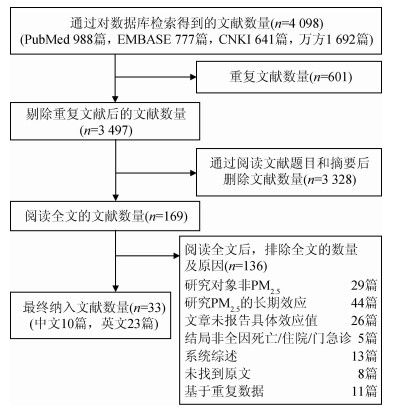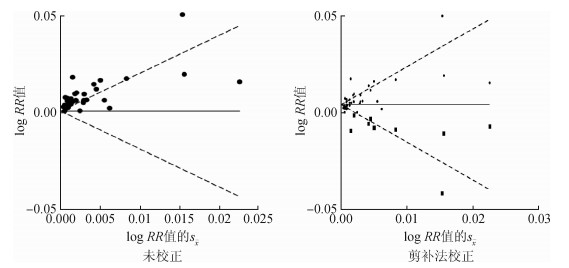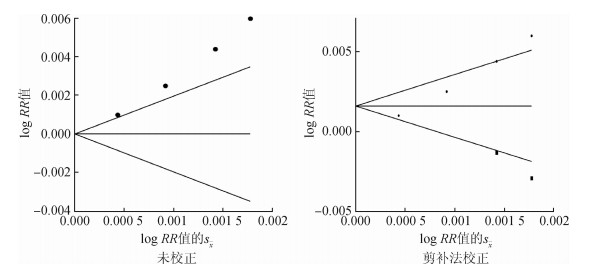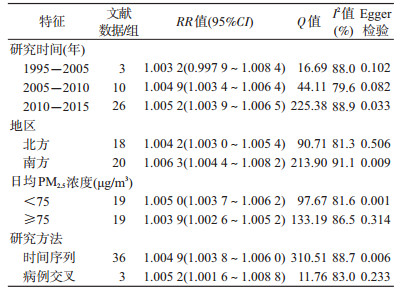文章信息
- 李曼, 吴瑶, 田耀华, 曹桂莹, 姚珊珊, 艾萍, 黄哲, 黄超, 王小文, 曹亚英, 项骁, 隽娟, 胡永华.
- Li Man, Wu Yao, Tian Yaohua, Cao Guiying, Yao Shanshan, Ai Ping, Huang Zhe, Huang Chao, Wang Xiaowen, Cao Yaying, Xiang Xiao, Juan Juan, Hu Yonghua.
- PM2.5短期暴露对我国死亡和急诊量影响的Meta分析
- A Meta-analysis on the relations between short-term exposure to PM2.5 and both mortality and related emergency visits in China
- 中华流行病学杂志, 2018, 39(10): 1394-1401
- Chinese Journal of Epidemiology, 2018, 39(10): 1394-1401
- http://dx.doi.org/10.3760/cma.j.issn.0254-6450.2018.10.019
-
文章历史
收稿日期: 2018-05-25
空气中粒径≤2.5 μm的颗粒物(PM2.5)严重威胁人类生命和健康,是世界范围内第五位死亡危险因素[1],也是我国第四位死亡危险因素[2],2015年造成420万人死亡和10 310万伤残调整寿命年(disability- adjusted life-years,DALYs)损失[1]。既往研究显示,PM2.5短期暴露与不良健康结局有关,如全因死亡[3]、呼吸系统疾病和心血管事件等[4]。据空气质量监测显示,2014—2015年我国年均PM2.5浓度远高于国家环境空气质量标准,其中88%(167/190)的城市PM2.5浓度超标[5]。PM2.5已对我国造成严重的疾病负担,2004—2016年我国归因于PM2.5的脑卒中、缺血性心脏病和肺癌的死亡数增长40余万,且该疾病负担也表现出时空特异性和地区聚集性的特点,其中长江三角洲、珠江三角洲和京津冀地区尤为严重[6]。
随着经济水平的提高和对健康重视程度的增加,我国政府也加强了PM2.5的监测和治理。2012年2月我国发布《环境空气质量标准》[7]将PM2.5 24 h平均浓度和年平均浓度监测指标纳入其中,要求在京津冀、长江三角洲、珠江三角洲等重点区域以及直辖市和省会城市开展细颗粒物监测,2013年扩展到113个环境保护重点城市和国家环境保护模范城市,到2015年监测范围已覆盖了所有地级以上城市。在此背景下,大量高质量的PM2.5数据使得我国研究者能够深入探究PM2.5浓度与人群健康结局的关系,进一步将这些研究成果进行定量分析和评价将为相关健康危险度评价工作、环境空气质量监测标准的制定以及环境空气质量的治理工作提供科学依据。国内已有的关于PM2.5与健康结局的系统综述多局限于死亡或某种疾病,少数研究并未进行发表偏倚校正[8-10]。鉴于此,本研究将系统收集和整理截止到2018年3月的相关文献,利用Meta分析定量评价PM2.5短期暴露与我国人群全因死亡和急诊量之间的关系。
资料与方法1.资料来源:由两位作者独立通过计算机联机检索中国知网(CNKI)、万方数据知识服务平台(万方数据库)、PubMed和EMBASE,截止到2018年3月29日收集相关文献4 098篇(其中CNKI数据库641篇,万方数据库1 692篇,PubMed 988篇,EMBASE 777篇)。
2.检索策略:以空气污染、大气污染、颗粒物、PM、死亡、急诊等关键词或主题词检索CNKI和万方数据库,以particulate、particle、PM、air pollution、admission、mortality、China等关键词或主题词检索PubMed和EMBASE。
3.文献纳入与排除标准:纳入标准:①研究暴露变量为PM2.5;②研究结局是全因死亡和急诊;③研究短期效应(效应时间<7 d);④研究方法主要为时间序列研究或采用病例交叉设计。排除标准:①文献的研究结果以绝对数(如死亡数)的形式表达;②系统综述;③重复报告、质量较差的文献;④研究的数据依赖他人研究数据或重复报道;⑤无法搜索到原文。
4.文献信息提取及质量控制:采用大气PM2.5浓度每上升10 μg/m3时居民每日全因死亡和急诊(门急诊人次和急诊救护车派遣量)的相对危险度(RR)、超额危险度(ER)为效应值。摘录信息包括作者、发表年份、研究类型、结局事件、定量的暴露-反应关系(如RR、ER值)及其95%CI。对每篇纳入的文献按照Newcastle-Ottawa Scale(NOS)文献质量评价量表进行质量评分。以上过程均由两人独立平行完成,若意见不一致则由第三人裁决。
5.统计学分析:研究首先描述所纳入文献的基本情况,然后对原始数据进行Meta分析并绘制森林图。Meta分析步骤:①异质性检验:利用Q检验和I2统计量检验研究间的异质性,以α=0.10为检验水准,若P<0.10或I2>50%,则表明各研究间存在异质性;②模型选择:根据异质性检验结果选择合并效应值的模型,若P<0.10或I2>50%则使用随机效应模型,反之则选择固定效应模型合并效应值;③亚组分析和Meta回归:使用亚组分析和Meta回归找出异质性来源;④发表偏倚检验:采用漏斗图法和Egger法(非参数直线回归法)对文献进行定性和定量的发表偏倚的检验,若存在发表偏倚,采用剪补法进行校正,重新合并效应值。为确保Meta分析结果的稳定性,最后计算失安全系数。本研究采用Excel 2010软件整理相关原始数据,利用Stata 14.0软件Meta分析模块进行统计学分析和绘制森林图,均为双侧检验。
结果1.文献概况:最终纳入33篇文献(23篇英文和10篇中文),检索流程见图 1。研究时间为1995—2015年,PM2.5浓度范围为47.7~176.7 μg/m3,涉及大中型城市(如北京、上海和成都等)。文献基本特征情况见表 1。

|
| 图 1 PM2.5短期暴露对我国死亡和急诊量影响相关研究检索流程 |
2. Meta分析:
(1) 以死亡为结局:以死亡为结局的数据有39组,Q检验和I2统计量检验显示,Q=322.46,P<0.10,I2=88.2%,提示各研究之间存在较大的异质性,故选用随机效应模型计算合并效应值,PM2.5对我国居民每日死亡短期效应RR=1.004 9(95%CI:1.003 9~1.005 9),见图 2A。

|
| 注:a同一文献不同地区 图 2 PM2.5对我国居民每日死亡/急诊短期效应的Meta分析森林图 |
(2) 以急诊量为结局:以急诊量为结局的数据有4组,Q检验和I2统计量检验显示,Q=12.76,P<0.10,I2=76.5%,提示各研究之间存在较大的异质性,故选用随机效应模型计算合并效应值,PM2.5对我国居民每日急诊短期效应RR=1.003 0(95%CI:1.001 0~1.005 1),见图 2B。
3.亚组分析和Meta回归:按研究时间、地区、日均PM2.5浓度及研究方法对PM2.5与全因死亡短期效应之间关系进行亚组分析,结果显示,北方地区合并效应值低于南方,研究期间PM2.5浓度<75 μg/m3的地区合并效应值高于PM2.5浓度≥75 μg/m3的地区(表 2)。Meta回归显示仅日均PM2.5浓度差异有统计学意义(P<0.05)。见表 3。
4.发表偏倚的检验与校正:
(1) 以死亡为结局:当以死亡为研究结局时,漏斗图明显不对称,定性判断可能存在发表偏倚(图 3)。使用Egger法(β=2.165 091,P=0.003)进一步定量检验提示该研究存在一定的发表偏倚(表 4)。采用剪补法进行校正后PM2.5的死亡效应研究的漏斗图无明显不对称(图 3),提示无发表偏倚。经异质性检验Q=430.60,I2=89.1%,P<0.01,故选择随机效应模型得到合并的RR=1.004 0(95%CI:1.002 9~1.005 0)。见表 5。进一步计算失安全系数为8 081.203 8。

|
| 图 3 剪补法校正发表偏倚前后PM2.5对我国居民每日死亡短期效应的Meta分析漏斗图 |
(2) 以急诊量为结局:当以急诊量为研究结局时,漏斗图明显不对称,定性判断可能存在发表偏倚(图 4)。使用Egger法(β=3.510 174,P=0.003)进一步定量检验提示该研究存在一定的发表偏倚(表 4)。采用剪补法进行校正后PM2.5的死亡效应研究的漏斗图无明显不对称(图 4),提示无发表偏倚。经异质性检验Q=22.919,I2=78.2%,P<0.01,故选择随机效应模型得到合并的RR=1.001 9(95%CI:0.999 7~1.003 5)。见表 5。进一步计算失安全系数为35.47。

|
| 图 4 剪补法校正发表偏倚前后PM2.5对我国居民急诊量短期效应的Meta分析漏斗图 |
大气颗粒物污染是现阶段中国城市严重的公共卫生问题[5],已成为我国研究热点。本研究共纳入33篇文献,发现PM2.5每上升10 μg/m3,居民每日死亡增加0.49%(95%CI:0.39%~0.59%),每日急诊量增加0.30%(95%CI:0.10%~0.51%)。既往国内外研究已显示PM2.5与居民全因死亡增加有关。2009年的1篇系统综述报告PM2.5浓度每增加10 μg/m3我国人群总死亡率上升0.40%(95%CI:0.19%~0.62%)[43]。2013年Shang等[10]对中国空气污染短期暴露与人群每日死亡的关系进行系统综述,报告PM2.5每升高10 μg/m3使得短期内居民总死亡率提升0.38%(95%CI:0.31~0.45)。2015年田璐等[8]针对我国人群的系统综述显示PM2.5每升高10 μg/m3使得居民每日总死亡的RR值为1.003 7(95%CI:1.002 7~1.004 9)。实际上,随着我国空气污染的严重程度和对其重视程度的逐渐增加,关于PM2.5与死亡的研究在近几年大量涌现,故本研究在以往研究的基础上对PM2.5和全因死亡的关系进行了更新,且结果与既往研究保持一致。然而,王德庆等[44]分别对我国、欧洲地区和北美地区进行系统综述,发现PM2.5每升高10 μg/m3,居民每日死亡率分别上升0.31%(95%CI:0.24%~0.37%)、1.26%(95%CI:1.15%~1.38%)和1.65%(95%CI:0.99%~2.30%)。Zanobetti和Schwartz[45]对美国112个城市进行多阶段时间序列分析,发现PM2.5每增加10 μg/m3使总死亡的合并超额风险增加0.98%(95%CI:0.75%~1.22%)。因此,与国外相关研究相比,本研究的结果与原始研究结果一致[3],均显示PM2.5对我国人群的短期效应值明显低于国外研究报告水平,其原因可能是国内外PM2.5的来源、浓度、组分不同以及人群易感性存在差异[3, 8]。
亚组分析显示我国南方地区PM2.5与全因死亡的短期效应关系大于北方。研究显示南方城市的颗粒物暴露系数[46]和暴露-反应关系系数[47]均大于北方城市,前者越大显示南方城市居民相较于北方城市居民更易暴露于PM2.5,后者越大则说明PM2.5每升高单位浓度所引起疾病死亡率增加的百分比越大。Chen等[3]分析出现这些差异的原因主要有南北方颗粒物来源及组成的差异、暴露错分、温度的效应修饰作用以及南北方年龄结构的差异等。同时,本研究结果还显示,PM2.5浓度低的地区效应值高于PM2.5浓度高的地区。既往研究显示当PM2.5处于较高水平时,其暴露-反应关系曲线反而趋于平坦[48]。
本研究结果显示,随着PM2.5浓度上升全因急诊量增加,这与原始研究保持一致[39-42]。同时,有研究显示心血管疾病和呼吸系统疾病作为空气污染的敏感性疾病,其急诊量也随PM2.5浓度增加而增加。Guo等[49]的研究显示PM2.5浓度每升高10 μg/m3会使得心血管疾病急诊量增加(OR=1.005,95%CI:1.001~1.009)。翟文慧等[50]对北京呼吸系统疾病就诊率与PM2.5日均浓度的关系进行研究,发现二者呈正相关(r=0.788)。
本研究存在局限性。在进行Meta分析时发现文献间异质性比较大,可能的原因是社区特定相对比率(community-specific relative rates)的地理和季节特异性导致PM2.5的化学成分产生差异[51]、各地区测量误差的影响、滞后天数的选择[52]、研究对象的异质性以及研究时间跨度大等。其次,本研究的结局是全因死亡和急诊量,未能将其进一步按照单病种进行划分。
利益冲突: 无
| [1] |
Cohen AJ, Brauer M, Burnett R, et al. Estimates and 25-year trends of the global burden of disease attributable to ambient air pollution:an analysis of data from the Global Burden of Diseases Study 2015[J]. Lancet, 2017, 389(10082): 1907-1918. DOI:10.1016/S0140-6736(17)30505-6 |
| [2] |
Yang GH, Wang Y, Zeng YX, et al. Rapid health transition in China, 1990-2010:findings from the Global Burden of disease Study 2010[J]. Lancet, 2013, 381(9882): 1987-2015. DOI:10.1016/S0140-6736(13)61097-1 |
| [3] |
Chen RJ, Yin P, Meng X, et al. Fine particulate air pollution and daily mortality. A nationwide analysis in 272 Chinese cities[J]. Am J Respir Crit Care Med, 2017, 196(1): 73-81. DOI:10.1164/rccm.201609-1862OC |
| [4] |
Newell K, Kartsonaki C, Lam KBH, et al. Cardiorespiratory health effects of particulate ambient air pollution exposure in low-income and middle-income countries:a systematic review and Meta-analysis[J]. Lancet Planet Health, 2017, 1(9): e368-380. DOI:10.1016/S2542-5196(17)30166-3 |
| [5] |
Maji KJ, Arora M, Dikshit AK. Burden of disease attributed to ambient PM2.5 and PM10 exposure in 190 cities in China[J]. Environ Sci Pollut Res Int, 2017, 24(12): 11559-11572. DOI:10.1007/s11356-017-8575-7 |
| [6] |
Liu MM, Huang YN, Ma ZW, et al. Spatial and temporal trends in the mortality burden of air pollution in China:2004-2012[J]. Environ Int, 2017, 98: 75-81. DOI:10.1016/j.envint.2016.10.003 |
| [7] |
中国环境科学研究院. 环境空气质量标准[M]. 北京: 中国环境科学出版社, 2012. Chinese Research Academy of Environmental Sciences. National Standard of the People's Republic of China Ambient Air Quality Standard[M]. Beijing: China Environmental Science Press, 2012. |
| [8] |
田璐, 金曼, 佟俊旺. 应用Meta分析研究我国PM2.5污染与居民每日死亡的关系[J]. 环境与职业医学, 2015, 32(11): 1013-1018. Tian L, Jin M, Tong JW. A Meta-analysis on association between air fine particular pollution and daily mortality of resident in China[J]. J Environ Occup Med, 2015, 32(11): 1013-1018. DOI:10.13213/j.cnki.jeom.2015.15138 |
| [9] |
Lu F, Xu DQ, Cheng YB, et al. Systematic review and Meta-analysis of the adverse health effects of ambient PM2.5 and PM10 pollution in the Chinese population[J]. Environ Res, 2015, 136: 196-204. DOI:10.1016/j.envres.2014.06.029 |
| [10] |
Shang Y, Sun ZW, Cao JJ, et al. Systematic review of Chinese studies of short-term exposure to air pollution and daily mortality[J]. Environ Int, 2013, 54: 100-111. DOI:10.1016/j.envint.2013.01.010 |
| [11] |
Venners SA, Wang BY, Xu ZG, et al. Particulate matter, sulfur dioxide, and daily mortality in Chongqing, China[J]. Environ Health Perspect, 2003, 111(4): 562-567. DOI:10.1289/ehp.5664 |
| [12] |
戴海夏, 宋伟民, 高翔, 等. 上海市A城区大气PM10、PM2.5污染与居民日死亡数的相关分析[J]. 卫生研究, 2004, 33(3): 293-297. Dai HX, Song WM, Gao X, et al. Study on relationship between ambient PM10, PM2.5 pollution and daily mortality in a district in Shanghai[J]. J Hyg Res, 2004, 33(3): 293-297. DOI:10.3969/j.issn.1000-8020.2004.03.010 |
| [13] |
Kan HD, London SJ, Chen GH, et al. Differentiating the effects of fine and coarse particles on daily mortality in Shanghai, China[J]. Environ Int, 2007, 33(3): 376-384. DOI:10.1016/j.envint.2006.12.001 |
| [14] |
Chen RJ, Li Y, Ma YJ, et al. Coarse particles and mortality in three Chinese cities:the China Air Pollution and Health Effects Study (CAPES)[J]. Sci Total Environ, 2011, 409(23): 4934-4938. DOI:10.1016/j.scitotenv.2011.08.058 |
| [15] |
Ma YJ, Chen RJ, Pan GW, et al. Fine particulate air pollution and daily mortality in Shenyang, China[J]. Sci Total Environ, 2011, 409(13): 2473-2477. DOI:10.1016/j.scitotenv.2011.03.017 |
| [16] |
Huang W, Cao JJ, Tao YB, et al. Seasonal variation of chemical species associated with short-term mortality effects of PM2.5 in Xi'an, a Central City in China[J]. Am J Epidemiol, 2012, 175(6): 556-566. DOI:10.1093/aje/kwr342 |
| [17] |
Yang CX, Peng XW, Huang W, et al. A time-stratified case-crossover study of fine particulate matter air pollution and mortality in Guangzhou, China[J]. Int Arch Occup Environ Health, 2012, 85(5): 579-585. DOI:10.1007/s00420-011-0707-7 |
| [18] |
Chen RJ, Wang X, Meng X, et al. Communicating air pollution-related health risks to the public:an application of the Air Quality Health Index in Shanghai, China[J]. Environ Int, 2013, 51: 168-173. DOI:10.1016/j.envint.2012.11.008 |
| [19] |
Li P, Xin JY, Wang YS, et al. Time-series analysis of mortality effects from airborne particulate matter size fractions in Beijing[J]. Atmos Environ, 2013, 81: 253-262. DOI:10.1016/j.atmosenv.2013.09.004 |
| [20] |
李湉湉, 崔亮亮, 陈晨, 等. 北京市2013年1月雾霾天气事件中PM2.5相关人群超额死亡风险评估[J]. 疾病监测, 2015, 30(8): 668-671. Li TT, Cui LL, Chen C, et al. Air pollutant PM2.5 related excess mortality risk assessment in Beijing, January 2013[J]. Dis Surveill, 2015, 30(8): 668-671. DOI:10.3784/j.issn.1003-9961.2015.08.015 |
| [21] |
Lee H, Honda Y, Hashizume M, et al. Short-term exposure to fine and coarse particles and mortality:a multicity time-series study in East Asia[J]. Environ Pollut, 2015, 207: 43-51. DOI:10.1016/j.envpol.2015.08.036 |
| [22] |
Zhou MG, He GJ, Fan MY, et al. Smog episodes, fine particulate pollution and mortality in China[J]. Environ Res, 2015, 136: 396-404. DOI:10.1016/j.envres.2014.09.038 |
| [23] |
冯文如, 刘世强, 黄勇, 等. 广州市PM2.5浓度与人群每日死亡风险的空间分布特征[J]. 环境卫生学杂志, 2015, 5(6): 512-519. Feng WR, Liu SQ, Huang Y, et al. Spatial distribution characteristics of PM2.5 in air and daily mortality in Guangzhou[J]. J Environ Hyg, 2015, 5(6): 512-519. DOI:10.13421/j.cnki.hjwsxzz.2015.06.006 |
| [24] |
He TF, Yang ZY, Liu T, et al. Ambient air pollution and years of life lost in Ningbo, China[J]. Sci Rep, 2016, 6: 22485. DOI:10.1038/srep22485 |
| [25] |
Lin HL, Liu T, Xiao JP, et al. Quantifying short-term and long-term health benefits of attaining ambient fine particulate pollution standards in Guangzhou, China[J]. Atmos Environ, 2016, 137: 38-44. DOI:10.1016/j.atmosenv.2016.04.037 |
| [26] |
Lin HL, Liu T, Xiao JP, et al. Mortality burden of ambient fine particulate air pollution in six Chinese cities:results from the Pearl River Delta study[J]. Environ Int, 2016, 96: 91-97. DOI:10.1016/j.envint.2016.09.007 |
| [27] |
Zhang FY, Liu XJ, Zhou L, et al. Spatiotemporal patterns of particulate matter (PM) and associations between PM and mortality in Shenzhen, China[J]. BMC Public Health, 2016, 16: 215. DOI:10.1186/s12889-016-2725-6 |
| [28] |
李沛.北京市大气颗粒物污染对人群健康的危害风险研究[D].兰州: 兰州大学, 2016. Li P. Study on hazard risk of atmospheric particlate matter to the population health in Beijing[J]. Lanzhou: Lanzhou University, 2016. http://www.wanfangdata.com.cn/details/detail.do?_type=degree&id=D01032926 |
| [29] |
张旭辉, 周伟杰, 张熙. 无锡市大气污染物对人群日死亡数和日就诊数影响的时间序列分析研究[J]. 环境卫生学杂志, 2016, 6(6): 407-411. Zhang XH, Zhou WJ, Zhang X. Time-series analysis on effects of air pollutants on daily mortality and daily outpatient visits in Wuxi, China[J]. J Environ Hyg, 2016, 6(6): 407-411. DOI:10.13421/j.cnki.hjwsxzz.2016.06.005 |
| [30] |
Li GX, Xue M, Zeng Q, et al. Association between fine ambient particulate matter and daily total mortality:An analysis from 160 communities of China[J]. Sci Total Environ, 2017, 599/600: 108-113. DOI:10.1016/j.scitotenv.2017.04.010 |
| [31] |
Zhang J, Liu Y, Cui LL, et al. Ambient air pollution, smog episodes and mortality in Jinan, China[J]. Sci Rep, 2017, 7(1): 11209. DOI:10.1038/s41598-017-11338-2 |
| [32] |
Zhu JY, Zhang XH, Zhang X, et al. The burden of ambient air pollution on years of life lost in Wuxi, China, 2012-2015:a time-series study using a distributed lag non-linear model[J]. Environ Pollut, 2017, 224: 689-697. DOI:10.1016/j.envpol.2017.02.053 |
| [33] |
Fang X, Fang B, Wang CF, et al. Relationship between fine particulate matter, weather condition and daily non-accidental mortality in Shanghai, China:a Bayesian approach[J]. PLoS One, 2017, 12(11): e0187933. DOI:10.1371/journal.pone.0187933 |
| [34] |
朱紫红. 广东省惠州市惠东县空气污染对居民死亡率的影响研究[J]. 中国医药科学, 2017, 7(18): 197-199. Zhu ZH. Study on the influence of air pollution of Huidong county in Huizhou city at Guangdong province[J]. China Med Pharm, 2017, 7(18): 197-199. DOI:10.3969/j.issn.2095-0616.2017.18.061 |
| [35] |
吴和岩, 谭爱军, 黄利群, 等. 珠海市大气污染物与居民每日死亡相关性的时间序列分析[J]. 环境与健康杂志, 2017, 34(9): 797-800. Wu HY, Tan AJ, Huang LQ, et al. Time-series analysis on association between atmospheric pollutants and daily mortality among residents in Zhuhai[J]. J Environ Health, 2017, 34(9): 797-800. DOI:10.16241/j.cnki.1001-5914.2017.09.012 |
| [36] |
Li TT, Yan ML, Sun QH, et al. Mortality risks from a spectrum of causes associated with wide-ranging exposure to fine particulate matter:a case-crossover study in Beijing, China[J]. Environ Int, 2018, 111: 52-59. DOI:10.1016/j.envint.2017.10.023 |
| [37] |
陈浪, 赵川, 关茗洋, 等. 石家庄市大气颗粒污染物浓度与居民死亡率的时间序列分析[J]. 中华疾病控制杂志, 2018, 22(3): 272-277. Chen L, Zhao C, Guan MY, et al. Time-series analysis of the relationship between particulate matter and mortality in Shijiazhuang[J]. Chin J Dis Control Prev, 2018, 22(3): 272-277. DOI:10.16462/j.cnki.zhjbkz.2018.03.014 |
| [38] |
奉琪, 苏莎, 张劲夫, 等. 长沙市城区大气PM2.5浓度与居民每日死亡关系研究[J]. 环境与职业医学, 2018, 35(2): 131-136. Feng Q, Su S, Zhang JF, et al. Association between PM2.5 concentration and daily resident mortality in urban area of Changsha[J]. J Environ Occup Med, 2018, 35(2): 131-136. DOI:10.13213/j.cnki.jeom.2018.17371 |
| [39] |
Wang X, Chen RJ, Meng X, et al. Associations between fine particle, coarse particle, black carbon and hospital visits in a Chinese city[J]. Sci Total Environ, 2013, 458-460: 1-6. DOI:10.1016/j.scitotenv.2013.04.008 |
| [40] |
王旭英, 李国星, 金晓滨, 等. 2012-2013年北京市大气PM2.5浓度与某三级甲等医院急诊人次相关性研究[J]. 中华预防医学杂志, 2016, 50(1): 73-78. Wang XY, Li GX, Jin XB, et al. Study of relationship between atmospheric fine particulate matter concentration and one grade a tertiary hospital emergency room visits during 2012 and 2013 in Beijing[J]. Chin J Prev Med, 2016, 50(1): 73-78. DOI:10.3760/cma.j.issn.0253-9624.2016.01.013 |
| [41] |
Chen GB, Zhang YM, Zhang WY, et al. Attributable risks of emergency hospital visits due to air pollutants in China:a multi-city study[J]. Environ Pollut, 2017, 228: 43-49. DOI:10.1016/j.envpol.2017.05.026 |
| [42] |
Liu RC, Zeng J, Jiang XY, et al. The relationship between airborne fine particle matter and emergency ambulance dispatches in a southwestern city in Chengdu, China[J]. Environ Pollut, 2017, 229: 661-667. DOI:10.1016/j.envpol.2017.06.098 |
| [43] |
谢鹏, 刘晓云, 刘兆荣, 等. 我国人群大气颗粒物污染暴露-反应关系的研究[J]. 中国环境科学, 2009, 29(10): 1034-1040. Xie P, Liu XY, Liu ZR, et al. Exposure-response functions for health effects of ambient particulate matter pollution applicable for China[J]. China Environ Sci, 2009, 29(10): 1034-1040. DOI:10.3321/j.issn:1000-6923.2009.10.006 |
| [44] |
王德庆, 王宝庆, 白志鹏. M2.5污染与居民每日死亡率关系的Meta分析[J]. 环境与健康杂志, 2012, 29(6): 529-532. Wang DQ, Wang BQ, Bai ZP. Meta-analysis of association between air fine particular and daily mortality of residents[J]. J Environ Health, 2012, 29(6): 529-532. DOI:10.16241/j.cnki.1001-5914.2012.06.027 |
| [45] |
Zanobetti A, Schwartz J. The effect of fine and coarse particulate air pollution on mortality:a national analysis[J]. Environ Health Perspect, 2009, 117(6): 898-903. DOI:10.1289/ehp.0800108 |
| [46] |
陈仁杰.复合型大气污染对我国17城市居民健康效应研究[D].上海: 复旦大学, 2013. Chen RJ. The health effects of complex air pollution in 17 Chinese cities[D]. Shanghai: Fudan University, 2013. http://cdmd.cnki.com.cn/Article/CDMD-10246-1014446788.htm |
| [47] |
Zhou B, Zhao B, Guo XF, et al. Investigating the geographical heterogeneity in PM10-mortality associations in the China Air Pollution and Health Effects Study (CAPES):a potential role of indoor exposure to PM10 of outdoor origin[J]. Atmos Environ, 2013, 75: 217-223. DOI:10.1016/j.atmosenv.2013.04.044 |
| [48] |
梁锐明, 殷鹏, 王黎君, 等. 中国7个城市大气PM2.5对人群心血管疾病死亡的急性效应研究[J]. 中华流行病学杂志, 2017, 38(3): 283-289. Liang RM, Yin P, Wang LJ, et al. Acute effect of fine particulate matters on daily cardiovascular disease mortality in seven cities of China[J]. Chin J Epidemiol, 2017, 38(3): 283-289. DOI:10.3760/cma.j.issn.0254-6450.2017.03.003 |
| [49] |
Guo YM, Jia YP, Pan XC, et al. The association between fine particulate air pollution and hospital emergency room visits for cardiovascular diseases in Beijing, China[J]. Sci Total Environ, 2009, 407(17): 4826-4830. DOI:10.1016/j.scitotenv.2009.05.022 |
| [50] |
翟文慧, 路晶凯, 王伟, 等. 北京市PM2.5污染特性及对老年呼吸系统疾病的影响[J]. 中国老年学杂志, 2015, 35(1): 210-211. Zhai WH, Lu JK, Wang W, et al. The characteristics of PM2.5 and its effects on the respiratory diseases of the elderly in Beijing[J]. Chin J Gerontol, 2015, 35(1): 210-211. DOI:10.3969/j.issn.1005-9202.2015.01.101 |
| [51] |
Bell ML, Ebisu K, Peng RD, et al. Hospital admissions and chemical composition of fine particle air pollution[J]. Am J Respir Crit Care Med, 2009, 179(12): 1115-1120. DOI:10.1164/rccm.200808-1240OC |
| [52] |
Anderson HR, Atkinson RW, Peacock JL, et al. Ambient particulate matter and health effects:publication bias in studies of short-term associations[J]. Epidemiology, 2005, 16(2): 155-163. DOI:10.1097/01.ede.0000152528.22746.0f |
 2018, Vol. 39
2018, Vol. 39







